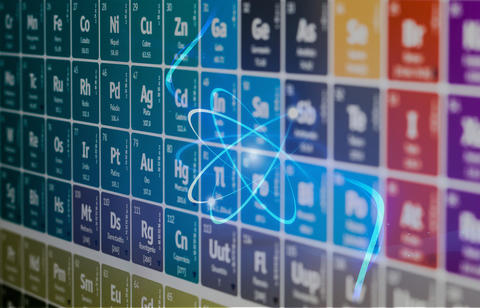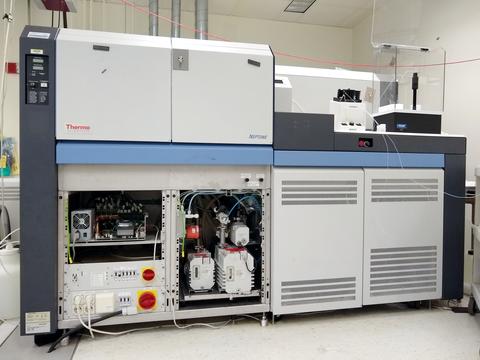Summary
Recent innovative advances in the design and manufacture of isotope ratio mass spectrometers (IRMS) have revolutionized the study of natural and man-induced isotopic variations. Currently, none of these high-precision isotopic measurement applications are tied to a traceable measurement system, and no measurement program is being pursued at any National Metrology Institute (NMI) to support these investigations. NIST SRMs certified for isotopic composition were developed decades ago and do not meet the increasingly stringent isotopic measurement needs of researchers in governmental, industrial, research, academic, and medical laboratories. NIST is implementing a program to produce and characterize a series of new isotopic reference materials in collaboration with other expert users and NMIs to underpin these measurements and quantify the measurement process.
Description

A new generation of multi-collector IRMS, utilizing both inductively coupled plasma and thermal ionization sample sources, is now capable of measuring isotope ratios with extremely high precision – a few parts in 106. This new measurement capability has caused a minor revolution in the use of isotopes by revealing small but significant isotopic variations in nearly all non-radiogenic poly-isotopic elements, many of which had been previously thought to have fixed isotopic abundances. These new measurements have also revealed not only mass dependent isotopic fractionations but also mass independent fractionations for selected elements. Isotopic variations are now being intensively studied in a considerably expanded research realm, for example chemical processes associated with the effects of human activities on the earth's ecosystems. Health, nutritional, and biochemical studies are also benefiting from the specificity of the high-precision isotopic measurements by enabling the non-invasive study of specific metal and protein uptake mechanisms and dose/response relationships in humans. Forensic and homeland security applications identifying adulteration and commodity provenance are also being vigorously pursued.
Currently, the analytical community is struggling to separate isotopic effects resulting from biases in the analytical measurement process from scientifically valid isotopic signatures resulting from natural processes. Producing a set of high-quality isotopic reference materials (RMs) should directly improve the quality and reliability of such measurements. This program will have an impact in several measurement sectors including:
- Medical – improved performance/specificity of clinical studies (e.g. calcium and osteoporosis, iron and hemochromatosis).
- Ecological – improved understanding of mass flux in natural systems and biogeochemical cycling of environmental pollutants to more rigorously guide models used for policy-making.
- Forensics – drug, food, and flavor provenance as well as identifying counterfeiting.
- Global Warming/Heavy Metal Cycling – refining and advancing global models of climate, photochemistry, and pollutant cycling due to climate change.

Major Accomplishments
- Organized and hosted a workshop on accurate high-precision isotopic reference materials for stakeholders from academia, research institutes, federal agencies, and other National Metrology Institutes (NMIs).
- System infrastructure developed for production of isotopic reference materials.
Additional Technical Details
A new series of isotopic reference materials will be created. These materials will be made from high-purity elements, will have isotopic abundances near the middle of their observed variation ranges, and will be isotopically homogeneous at the sub-microgram per gram level. In some cases where naturally or anthropogenically induced isotopic variations are large, a second isotopically enriched RM may be made. The reference materials will be packaged to ensure their long term (≈15 to 20 years) isotopic stability, and a sufficient stock will be generated to ensure that the user community has access to this material over this same time period. This latter requirement is particularly important because these RMs will anchor "delta-scales" for each of the isotopic systems.
These new isotopic materials will require a multi-collector inductively coupled plasma mass spectrometer (MC-ICP-MS) coupled with a liquid sample introduction system for RM characterization. Utilization of such a system for value assignment of the isotopic RMs will involve a number of technical challenges, principally centered on how to accurately correct for instrumental mass bias and to a lesser degree chemical biases in samples. The traditional "atomic weights" calibration approach cannot be used as it is limited to precisions of only a few parts in 104. An important component of this effort will be the utilization of internal spike and standard-sample bracketing techniques that have been developed at NIST and elsewhere to characterize instrument biases. It is anticipated that the availability of these new isotopic reference materials will be a substantive aid to separating instrumental artifacts from actual artifacts.
Associated Products
NIST is in the process of producing a series of isotopic standard solutions, similar to the SRM 3100 elemental series spectrometric solutions
Development of a web-based information delivery system for wider dissemination of information on the isotopic standards and appropriate validation procedures.
Provide vetted approaches to data reduction and validation for the various elemental systems.

